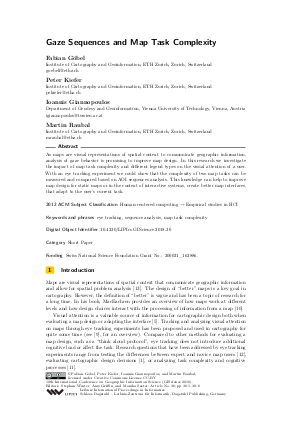Gaze Sequences and Map Task Complexity (Short Paper)
Authors Fabian Göbel, Peter Kiefer, Ioannis Giannopoulos, Martin Raubal
-
Part of:
Volume:
10th International Conference on Geographic Information Science (GIScience 2018)
Part of: Series: Leibniz International Proceedings in Informatics (LIPIcs)
Part of: Conference: International Conference on Geographic Information Science (GIScience) - License:
 Creative Commons Attribution 3.0 Unported license
Creative Commons Attribution 3.0 Unported license
- Publication Date: 2018-08-02
File

PDF
LIPIcs.GISCIENCE.2018.30.pdf
- Filesize: 7.71 MB
- 6 pages
Document Identifiers
Subject Classification
ACM Subject Classification
- Human-centered computing → Empirical studies in HCI
Keywords
- eye tracking
- sequence analysis
- map task complexity
Metrics
- Access Statistics
-
Total Accesses (updated on a weekly basis)
0PDF Downloads0Metadata Views
Abstract
As maps are visual representations of spatial context to communicate geographic information, analysis of gaze behavior is promising to improve map design. In this research we investigate the impact of map task complexity and different legend types on the visual attention of a user. With an eye tracking experiment we could show that the complexity of two map tasks can be measured and compared based on AOI sequences analysis. This knowledge can help to improve map design for static maps or in the context of interactive systems, create better map interfaces, that adapt to the user's current task.
Cite As Get BibTex
Fabian Göbel, Peter Kiefer, Ioannis Giannopoulos, and Martin Raubal. Gaze Sequences and Map Task Complexity (Short Paper). In 10th International Conference on Geographic Information Science (GIScience 2018). Leibniz International Proceedings in Informatics (LIPIcs), Volume 114, pp. 30:1-30:6, Schloss Dagstuhl – Leibniz-Zentrum für Informatik (2018)
https://doi.org/10.4230/LIPIcs.GISCIENCE.2018.30
BibTex
@InProceedings{gobel_et_al:LIPIcs.GISCIENCE.2018.30,
author = {G\"{o}bel, Fabian and Kiefer, Peter and Giannopoulos, Ioannis and Raubal, Martin},
title = {{Gaze Sequences and Map Task Complexity}},
booktitle = {10th International Conference on Geographic Information Science (GIScience 2018)},
pages = {30:1--30:6},
series = {Leibniz International Proceedings in Informatics (LIPIcs)},
ISBN = {978-3-95977-083-5},
ISSN = {1868-8969},
year = {2018},
volume = {114},
editor = {Winter, Stephan and Griffin, Amy and Sester, Monika},
publisher = {Schloss Dagstuhl -- Leibniz-Zentrum f{\"u}r Informatik},
address = {Dagstuhl, Germany},
URL = {https://drops.dagstuhl.de/entities/document/10.4230/LIPIcs.GISCIENCE.2018.30},
URN = {urn:nbn:de:0030-drops-93587},
doi = {10.4230/LIPIcs.GISCIENCE.2018.30},
annote = {Keywords: eye tracking, sequence analysis, map task complexity}
}
Author Details
- Department of Geodesy and Geoinformation, Vienna University of Technology, Vienna, Austria
Funding
Swiss National Science Foundation Grant No.: 200021_162886.
References
-
Alžběta Brychtová and Arzu Çöltekin. An Empirical User Study for Measuring the Influence of Colour Distance and Font Size in Map Reading Using Eye Tracking. The Cartographic Journal, 53(3), 2016.

-
Henry W. Castner and Ronald J. Eastman. Eye-Movement Parameters and Perceived Map Complexity - I. Cartography and Geographic Information Science, 11(2), 1984.

-
Arzu Çöltekin, Sara I. Fabrikant, and Martin Lacayo. Exploring the efficiency of users' visual analytics strategies based on sequence analysis of eye movement recordings. International Journal of Geographical Information Science, 24(10), 2010.

-
Ioannis Giannopoulos, Peter Kiefer, and Martin Raubal. GeoGazemarks: Providing Gaze History for the Orientation on Small Display Maps. In Proceedings of the 14th ACM International Conference on Multimodal Interaction (ICMI '12), New York, New York, USA, 2012. ACM Press.

-
Fabian Göbel, Ioannis Giannopoulos, and Martin Raubal. The importance of visual attention for adaptive interfaces. In Proceedings of the 18th International Conference on Human-Computer Interaction with Mobile Devices and Services Adjunct - MobileHCI '16, New York, New York, USA, 2016. ACM Press.

-
Fabian Göbel, Peter Kiefer, Ioannis Giannopoulos, Andrew T. Duchowski, and Martin Raubal. Improving Map Reading with Gaze-Adaptive Legends. In ETRA '18: 2018 Symposium on Eye Tracking Research & Applications. ACM, 2018, (to appear).

-
Kenneth Holmqvist and Richard Andersson. Eye Tracking: A comprehensive guide to methods, paradigms and measures. CreateSpace, Lund, 1 edition, 2017.

-
Peter Kiefer and Ioannis Giannopoulos. Gaze Map Matching: Mapping Eye Tracking Data to Geographic Vector Features. In Proceedings of the 20th International Conference on Advances in Geographic Information Systems, SIGSPATIAL '12, New York, New York, USA, 2012. ACM.

-
Peter Kiefer, Ioannis Giannopoulos, Martin Raubal, and Andrew Duchowski. Eye Tracking for Spatial Research: Cognition, Computation, Challenges. Spatial Cognition & Computation, 17, 2017.

-
Alan M. MacEachren. How Maps Work Representation, Visualization, and Design. Guilford Press, 2004.

-
Daniel R. Montello. Cognitive Map-Design Research in the Twentieth Century: Theoretical and Empirical Approaches. Cartography and Geographic Information Science, 29(3), 2002.

-
Kristien Ooms, Philippe De Maeyer, Veerle Fack, Eva Van Assche, and Frank Witlox. Interpreting maps through the eyes of expert and novice users. International Journal of Geographical Information Science, 26(10), 2012.

-
Terry A. Slocum, Robert B. McMaster, Fritz C. Kessler, and Hugh H. Howard. Thematic Cartography and Geovisualization. Pearson, Upper Saddle River, New Jersey, USA, 3 edition, 2009.

